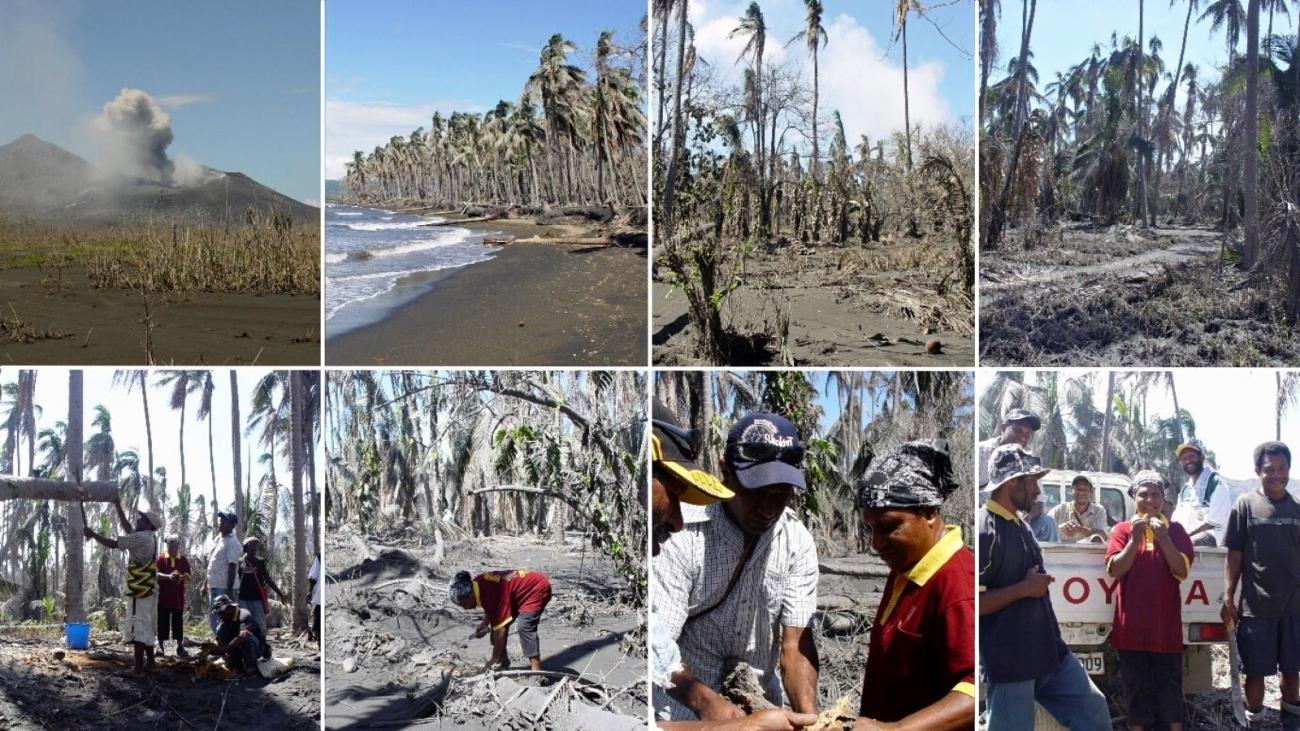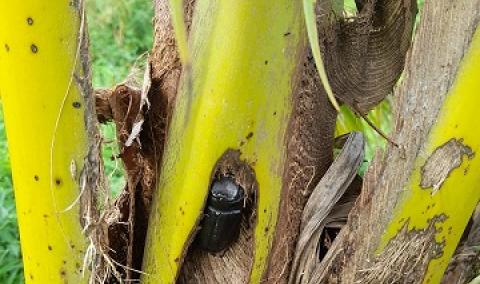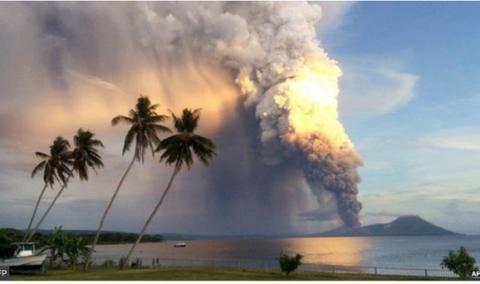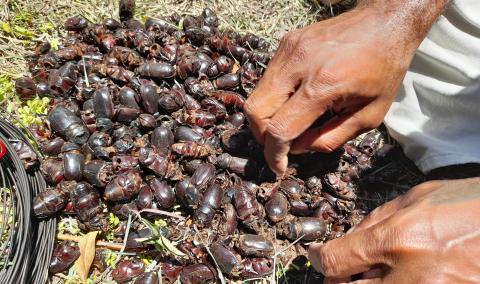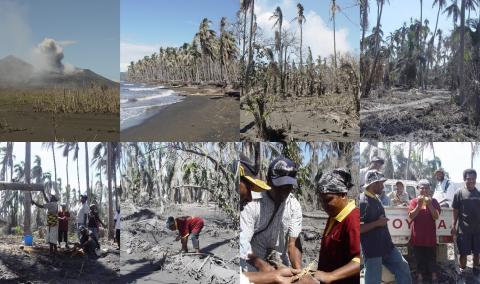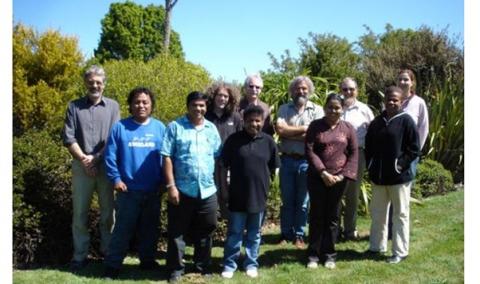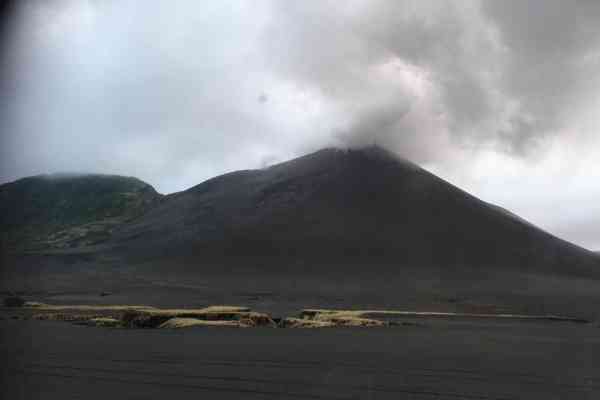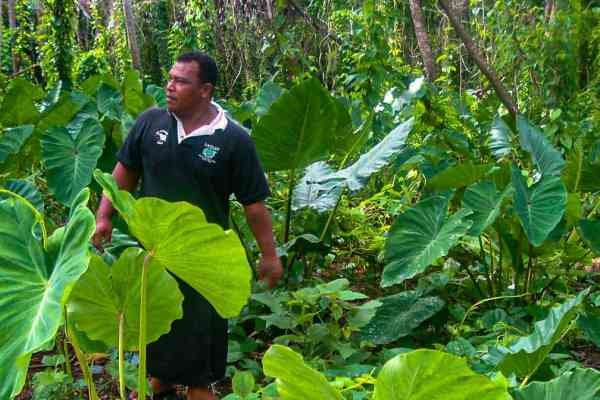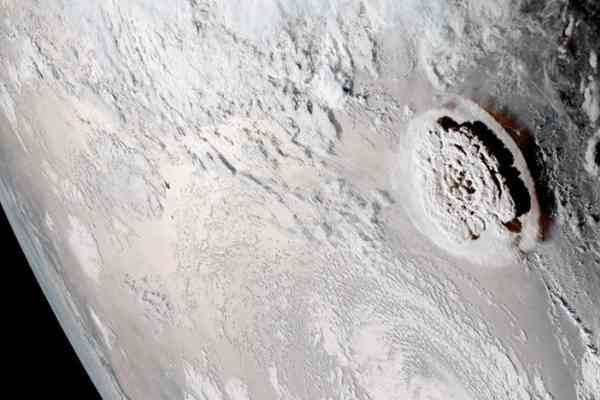The volcanic eruption and tsunami in Tonga remind us of the power of nature and the vulnerability of small Pacific Island communities. The immediate consequences of ash and destruction are spectacular, but the longer-term effects and disruption of agricultural production are less obvious. One of the consequences of these natural disasters is a large number of dead coconut palms with decaying organic matter. This is the perfect breeding material for the coconut rhinoceros beetle (CRB), one of the most prominent pests in the region. In the aftermath of the Tonga eruption, action needs to be taken to avoid a surge of pests and the failure of coconuts as a staple food and source of income. During our work in the Pacific, we have worked with local scientists in Papua New Guinea and Fiji to establish controls for CRB in the aftermath of volcanic eruptions and cyclones.
In East New Britain, Papua New Guinea, the Tavurvur volcano erupted in 1996 and destroyed much of the town of Rabaul and surrounding villages. A second eruption occurred in 2006 causing further ash falls and damage.
I visited the site as part of the “Capacity building for improved biocontrol of food crop pests in the South Pacific” with Kiteni Kurika of Laes, PNG in 2008. Kiteni had attended our training course at Lincoln the previous year.
Kiteni had returned to PNG and had been approached to help the local recovery efforts for the village gardens and I was able to visit the Matupit Peninsula with her team to see the problems first-hand. The volcano had been spewing fresh clouds of ash, rendering all surfaces a uniform grey. The coconut palm fronds and most of the immature nuts had already dropped. The ground was covered with a thick layer of pumice dust and many of the buildings had collapsed under the weight of the ash. Despite the difficulty of the situation, villagers were trying to clear the ash, recover their land and start again.
These short-term difficulties were leading to longer term problems. Dead palm trunks left after the eruption are the ideal material for development of larvae of the coconut rhinoceros beetle and many were evident in the decaying material. Once the larvae emerge as adult beetles, they attack the remaining living palms. With high numbers, they will kill the palms and continue the destructive cycle. The only remedies are to clean up the decaying material, destroy the larvae and release biological controls for wider area suppression.
The area was surveyed, and beetles were collected to test for presence of the biocontrol Oryctes NudiVirus. Interestingly, PCR tests revealed a high percentage of the beetles infected with the virus that had been previously released for biocontrol in the 1980’s. However, with so much breeding material larvae were numerous and even virus weakened adult beetles caused a lot of damage. The PNG team have continued with an integrated pest management programme to support the villagers. PNG scientists now participate in the CRB Action Network
I revisited the area in 2016 with Solomon Sar (PNGOPRA) and Anna Kawai (NAQIA) and surveyed the damaged area in Matupit. Village life was returning, although it was not quite back to normal yet.. The majority of palms (97%) showed some evidence of CRB feeding through leaf notching, but severe damage was rare. Molecular analysis of the collected beetles at the site from AgResearch showed that they belonged to the virus susceptible CRB clade II that arrived in the offshore islands during World War II. Assessment of palms at Kerevat and Kokopo, outside of the area affected by the volcano, showed only minor damage with less than 20 per cent of palms infected. The virus has become endemic in the region.
When Cyclone Winston hit Fiji in Feb 2016 it created the worst disaster to have ever affected the country. It was the strongest tropical cyclone ever recorded to make landfall in Fiji, causing 44 deaths and affecting up to 350,000 people. Winds of over 200 kph caused a swathe of damage across the Northeast of Viti Levu and hit the islands of Vanua Levu, Taveuni, and others. In addition to killing 44 people, destroying, or damaging 40,000 houses and leaving many homeless, the cyclone stripped fronds and nuts from the coconut palms and broke and toppled many to leave only dead standing stems and the loss of this important food source. While the reconstruction of houses and commercial buildings was the initial priority, the dead and decaying palms constituted a severe risk with potential for a second disaster from emergence of large numbers of coconut rhinoceros beetles in the decaying trunks. Fortunately, later in 2016, a team of CRB experts had assembled in Fiji for an “End of Project” workshop on the AgResearch led “Biological Control Activity in Selected Pacific Island Countries”. Members of the team were able to visit the damaged zone on Viti Levu and warned of the danger of a massive outbreak of CRB if no effective control measures were taken. MFAT provided funding for a contract extension, and we were able to work with the Ministry of Forests (MAF) Fiji to assist the response on Viti Levu and Taveuni islands. Villagers collaborated with MAF in identification of hotspots, clean-up of breeding materials and management and the worst effects of an outbreak were avoided.
On the Pacific islands, CRB thrives when there is an abundance of breeding materials, principally dead palm trees. Natural disasters, such as volcanoes, tsunamis, and cyclones, cause extensive destruction of palms that inevitably leads to beetle outbreaks. Other forms of land use disruption, such as plantation renovation, can also lead to CRB outbreaks. It is important that response managers are aware of this threat which is often overlooked in the urgency of the initial humanitarian response to natural disasters.
AgResearch and The Pacific Community have produced a manual for management of CRB which contains techniques which can be adapted for response to natural disasters and general plantation management. Access the manual here.
For more information, please contact:
Dr Mark Ero, Project Manager for the Pacific Awareness and Response to Coconut Rhinoceros Beetles (PARC), Land Resources Division (LRD), The Pacific Community, [email protected]
For general enquiries:
Communications on pest and disease incidents of interest to the Pacific region should be addressed to the Plant Health Team, Land Resources Division, Pacific Community, Private Mail Bag, Suva, Fiji Islands | Tel: (+679) 3370733. Fax: (+679) 3370021. Email: [email protected] or [email protected].
